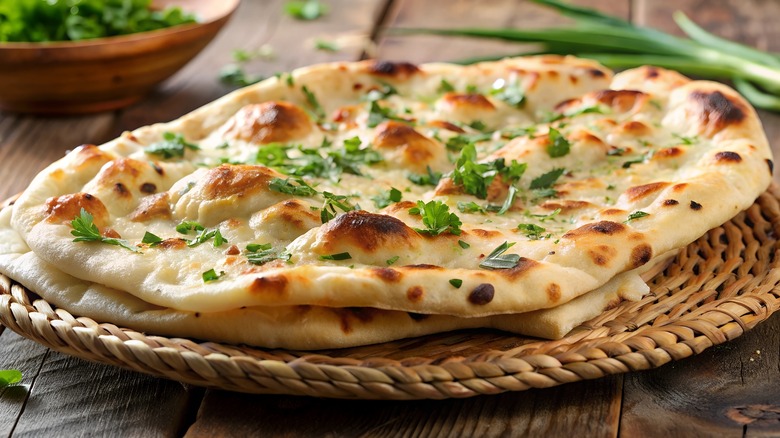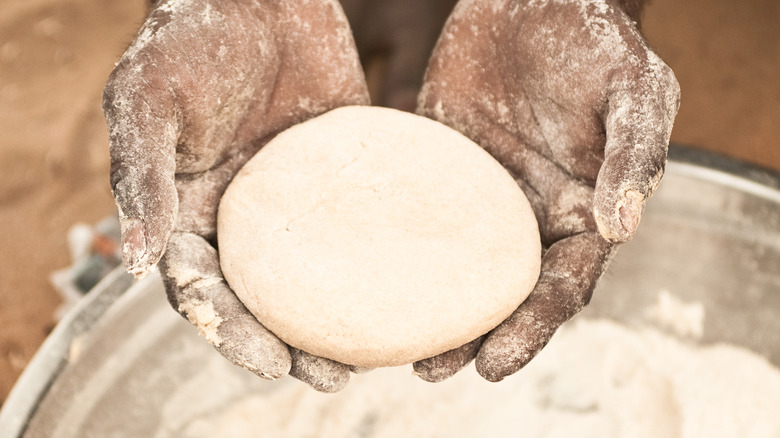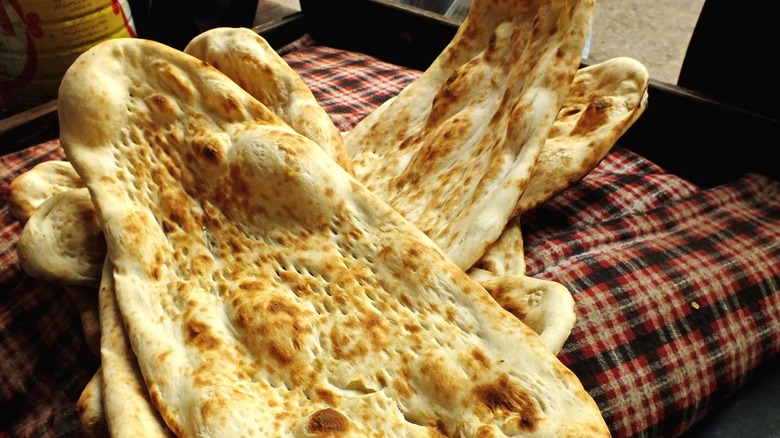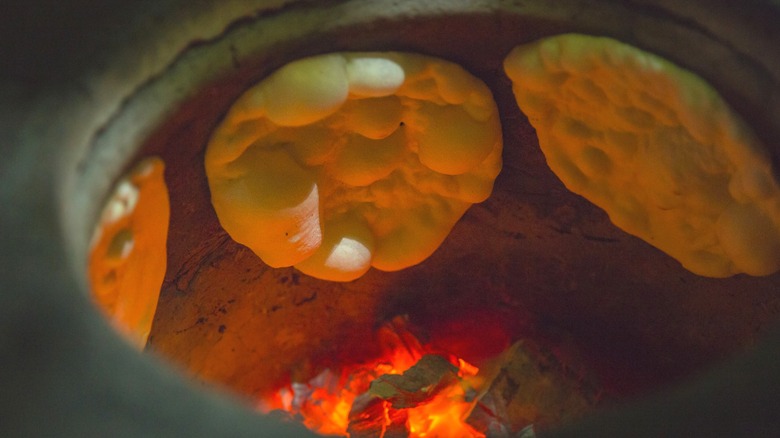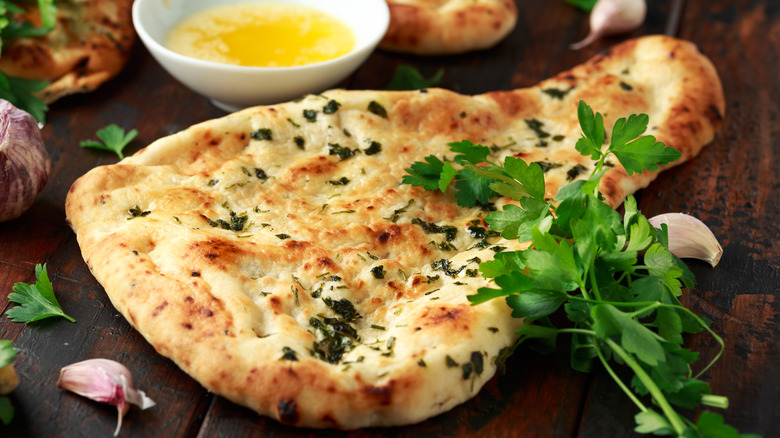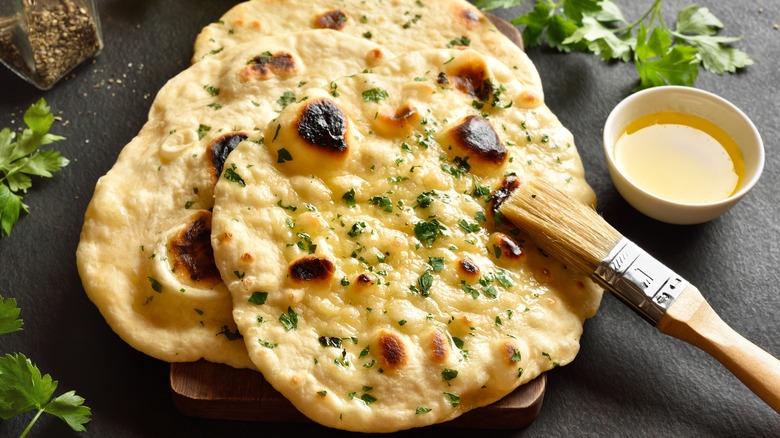Everything You Need To Know To Bake Soft Pillowy Naan At Home
When it comes to sitting down for a curry, the table is always going to feel bare if there isn't naan at hand. At Indian restaurants, you can order delicious, fresh-baked naans to dip in your food and use as a utensil as much as a side dish. But when you get home, it might seem impossible to replicate those fluffy flatbreads. There are stovetop recipes that will try to approximate authentic naan in a rush and you can get store-bought imitations to heat up before eating a pumpkin curry soup. While these naans are better than nothing, you can make something much better at home. You just need to know who to ask.
Chowhound spoke exclusively with Varun Inamdar, who shared some secrets to preparing your own perfect pillowy naan at home. Inamdar is the chef and owner of 27 Degrees West in Singapore, Anokhi Bar & Grill in Shanghai, and New Light Sopore in Kashmir. He also shares recipes and tips on the popular YouTube channel Rajshri Food, where home cooks can find videos of 100% vegetarian recipes. Before getting into the details of making naan, Inamdar laid out the basics: "The secret to baking soft, pillowy naan at home lies in replicating the intense heat of a traditional tandoor and maintaining moisture in the dough."
Making the naan dough right
Naturally, the first element to get right with naan is the dough. Unlike quick breads, which depend on baking soda or baking powder to rise, naans are leavened breads, so they have yeast that needs sugar and liquid to do its thing. However, you need to use the right moisture in your naan dough to get it to come out perfectly. "Use yogurt, milk, or a combination of both in your dough recipe. This adds moisture and fat, which helps create that soft, pillowy texture," Varun Inamdar advises, adding, "Sometimes, an egg also goes a long way, if one is okay with its inclusion." But the dough isn't done as soon as you've brought the ingredients together. "Allow the dough to rest and ferment for a few hours, making it more elastic and airy," he says.
The importance of the authentic naan shape
Whenever you order naan or pick some up at the grocery store (Trader Joe's naan is a great option for grilled cheese sandwiches), you'll notice that they typically have a tapered shape with one end much wider than the other. This might seem like it's just an aesthetic element. However, that classic tear-drop shape of naan benefits more than your eyes.
Once you have rolled out the dough, Varun Inamdar highlights the importance of giving the bread its authentic shape. "This thinner tip will bake faster and puff up, creating the texture naan is known for," he notes. While you generally want to make sure that things cook evenly when baking, with naan, the irregular shape and the uneven baking are an important part of the recipe.
The right heat for baking your naan
The biggest mistake that will foil your attempts to make perfect naan at home all comes down to heat. Naan is traditionally baked in a tandoor (which is also the origin of tandoori chicken). A tandoor is an oven traditionally made of clay that can maintain a heat of around 900 degrees Fahrenheit. While you can get a skillet pretty hot, the hot air escaping is the crux of why stovetop naan will be good, but not perfect.
If you happen to have a tandoor at home, you should definitely use that for your naans. However, for the rest of us, Varun Inamdar has a way to get close enough to that environment in a home kitchen. "Preheat your oven to its highest setting (around 250°C/480°F). If possible, use a pizza stone or a heavy baking tray to mimic the tandoor's intense heat. Heat it up for at least 30 minutes before baking the naan," he says. While that's obviously not as hot as a tandoor, pizza stones hold onto heat in a more similar way to the clay of a tandoor, so laying your naan directly onto one can simulate the classic method of putting the naan dough on the inner walls of the tandoor.
How long it takes to cook a perfect naan
You've prepped your dough, let it ferment for hours, stretched it into an authentic tear-drop shape, and waited for your oven to heat your pizza stone. By this point, your curry is probably ready and you'd like to eat some naan. The good news is that the perfect way to cook a naan can be summed up in one word: quickly.
The oven (or, ideally, tandoor) should be so hot that the naan does not need to be in there for very long. In fact, leaving it in for more than just a couple of minutes could make it much worse. Varun Inamdar points out what to look for when baking your naan: "Place the rolled-out naan onto the preheated stone or tray, and bake for just 2-3 minutes, until it starts to puff up with some char spots. Avoid overbaking, as this will dry out the naan."
The final touch before your naan is finished
Of course, just because your naan has finished baking, doesn't mean that it's quite ready to eat. And that's not just because you'd burn your mouth. There's one last touch to ensure that your homemade naan has that signature flavor. "As soon as the naan comes out of the oven, brush it generously with melted butter to keep it moist and add flavor," says Varun Inamdar. Of course, you can also switch it up if you want to go a step further than traditional unsalted butter. You can reach for some clarified butter (commonly known as ghee) or splash some garlic on there for another classic twist.
